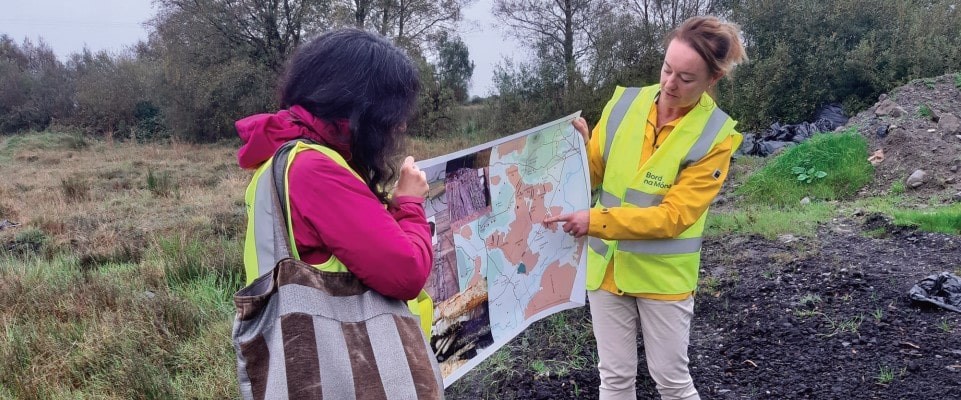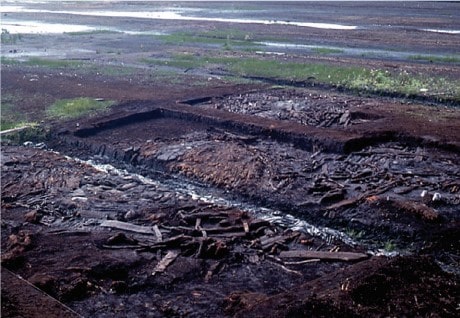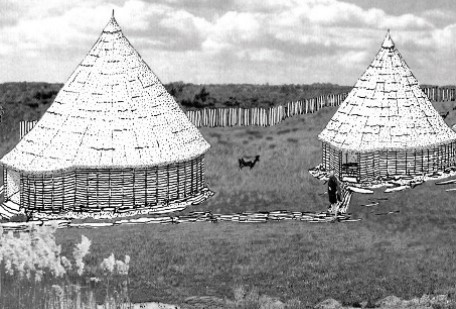In This Section
What Lies Within the Peat: our vast and unique archaeological heritage - Ellen O'Carroll

Raised Bogs in Ireland preserve a wealth of archaeological sites and artefacts unparalleled anywhere else in the world.
These bogs are also a unique repository of information on past climates, vegetation and are now being rehabilitated for biodiversity and carbon sequestration.
Excavations and surveys in advance of developments such as peat extraction, mines, wind farms and roads have demonstrated the archaeological value of peatlands. Sites and artefacts are exposed on the bog surface and in the drain faces as a consequence of extensive peat extraction. Archaeologists then carry out surveys and excavations to record and interpret these sites in advance of further destruction through development. The Lisheen Mine Archaeological Project 1996-8 and 2018, undertaken in advance of the development of a lead-zinc mine at Lisheen, Co. Tipperary uncovered over 100 peatland sites of prehistoric to medieval date, while investigations on the adjacent dryland found 20 associated sites including prehistoric houses and a flat cemetery. In 2006 excavations at Edercloon, Co. Longford in advance of the N4 Dromod-Roosky By-Pass, saw the excavation of 44 sites supported by an extensive programme of palaeoenvironmental analysis. Many of the sites at Edercloon formed part of a unique prehistoric complex defined in part by ritual deposition of objects.
The 2013 Peatland Review recorded that over 64,000 hectares of industrial raised bog had been surveyed by archaeologists, with over 4,000 archaeological sites identified. Up to and including 2011 there had been 350 excavations completed on our raised bogs. However, the number of sites excavated is less than 10% of the known total.
A wide range of archaeological sites and artefacts survive within and under Irish peatlands. The anoxic (oxygen free) conditions of peat means that organic materials such as wood, leather, textiles and human bodies survive in excellent conditions. These materials do not survive as well on dryland sites and thus their recovery adds greatly to the record of our past. Trackways, which aided the safe crossing of treacherous bogland, are the most common site encountered. These can be constructed from either wood, gravel or flagstones and were in use from over 6,000 years ago up to relatively recently.

Other sites include settlements such as the Bronze Age enclosed settlement at Clonfinlough, Co. Offaly which was partially excavated in 1991. This had been preserved in fen bogland in an area of industrial drained peat.
One of the earliest known sites was uncovered at Lough Boora, Co. Offaly and comprised a Mesolithic (8,000 years old) encampment where our earliest ancestors fished, ate, lived and foraged. Many hundreds of smaller wooden platforms and hurdle panels laid down within bogs have also been uncovered and are indicators that the peatlands provided resources such as reeds, rushes and gaming of wildfowl.

Wooden stakes were felled, sharpened and then painstakingly hammered across our bogs as boundaries or markers to aid access through these vast areas. Bogs were also the focus of ritual activity as shown by the discoveries of bog bodies and hoards of metalwork.
With the ending of industrial peat extraction and the allocation of significant funding towards rehabilitation, it is now time to take stock of what we have learnt from the last 40 years of archaeological work, and gain a comprehensive understanding of this vast and important heritage resource for local communities and the promotion of the value of ‘green solutions’ to the current climate crisis. The peatland archaeological record represents a key resource for community groups engaged in peatland conservation initiatives, offering significant future benefits to Irish society in general, including a deeper sense of place, cultural identity and as assets for tourism.
The Irish Peatland Archaeology Across Time (IPeAAT) project which is funded by the Irish Research Council COALESCE/INSTAR+ scheme, University College Cork and involving colleagues from Archaeology and Built Heritage Ltd, University College Dublin, the National Museum of Ireland, Bord na Mόna and theNational Monuments Service are currently addressing this task. A database is being compiled of excavated archaeological sites and associated information including palaeoenvironmental data. This database will be available to the public and will address important research questions about the nature and purpose of past human activities and interaction with peatlands.
Moving into the future we need to take stock of what we have uncovered and how best to preserve this unique archaeological heritage in tandem with the rehabilitation phase of works. - Ellen O’Carroll
For more on this story contact:
Dr Ellen O'Carroll
Irish Peatland Archaeology Across Time (IPeAAT)
Contact us
